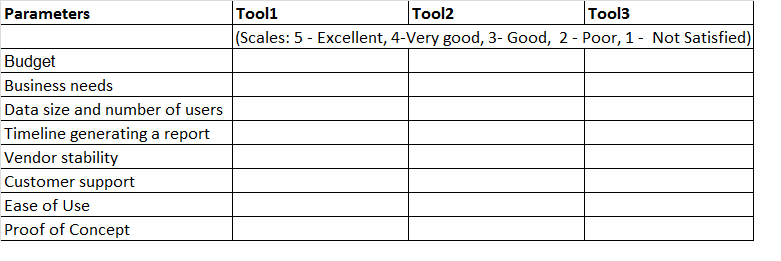BI market is growing day by day. There are several BI Reporting tools available in the market and choosing that “One” tool for your business becomes very critical. Choosing a tool in haste often results in ending up with a tool with limitations or moving to a new tool. This results in twice the amount of time and effort which directly has a cost impact as well. Hence it is important to evaluate and choose the right tool. As a first step, let’s apply a broader filter to narrow down to a smaller set of tools.
Understand your business needs:
There are various analytics available, some of them are:
- Self-Service Analytics: Provide powered user customers access to analytics tools
- Predictive Analytics: Provides metrics to understand customer behavioural patterns.
- Social Media Analytics: Helps in decision making from vast amount of scattered data available in the Social sites.
- Big Data Analytics : Provides useful information and discover patterns from big data to help in business
- Cloud Analytics: Provides SaaS-based data warehousing and BI Analytics on public or private Cloud.
- Real-Time Analytics: Provides real time, up to the minute self-explanatory, business-oriented analytics
- Mobile Analytics: Provides the information accessible in mobile in a user friendly way.
Depending on your business needs you can choose tools that are stronger on that analytics. Hence depending on the sector you belong to, the focus of your business and the pain points in your business you need to choose the tool.

Most of the leading BI Tool players in the market have both the cloud and on-premise version in the market. Some of them are Microstrategy, Birst, SAP Business Objects
Envision the size of the data and number of users:
Extrapolating today’s data to 10 years down the line will help us envision the size of the data to be handled. If yours is product based / SaaS based company then the amount of data would be growing with your customer base. And if you are offering BI Reports along with your product then performance and scalability becomes a key factor in selection.
Timeline for building/generating a report:
How quickly your business needs the reports is a key factor. There are very robust tools like Microstrategy which will give you amazing reports; but, it will take quite some time to build these reports. There are tools like QlikView, where you can build reports in a shorter span of time. There are BI tools available in cloud which helps us reduce the installation time and cost and develop dashboards and reports more quickly.
The above criteria are the major factors which will help us reduce the list to a smaller subset of products to choose from.
Budget:
There are different set of tools available in the market that fits into varied size of the budget. Understand the budget you have in place before looking at the tools. For e.g.,
- Some of the BI Tool leaders in the commercial market are Microstrategy, IBM Cognos, Qlik View, Tablaeu, Oracle BI, Microsoft PowerBI, SAP BO
- Some of the players in the open source market are Jasper Report, Birst, SpagoBI, Pentaho
Vendor stability:
It is important to understand the vendor stability and their growth plans. BI is a long-term investment for any organization. Often times, it will take significant amount of time once you build your data warehouse, get insights through BI and make them for making business decisions. Spend time in understanding your vendor’s technology roadmap and their growth plans.
Customer support:
Good documentation, strong knowledge base and good customer support is a definite need. As developers work across the time zones, 24/7 technical support would be an added advantage. Make sure that your BI tool vendor provides excellent customer support.
Ease of Use:
However flashy your reports may be and how ever important the information may be if the end user finds it difficult to use the tool then it is going to be of no use. Hence make sure to involve your end users in the tool selection process. Allow them to be part of the demos and decision making committee.
Proof of Concept:
It is always handy to request for a product demo before playing around with trial versions. Another good practice would be to develop a proof of concept; come up with few use cases say 8 to 10. These should be from simple to medium complex. This will help us get familiarized with the product and gain hands on experience which enables us to identify the below:
- How easy is it to develop and maintain reports?
- The timeline for the report to come to shape.
- How much training is required for users to get used to the tool?
- How good is their post sales product support?
A POC development generally takes 4 or 5 days including the time taken to set up the environment and to run through the use cases.
Here is the sample of the scoring system
It is worth taking time to decide on an appropriate and the right tool for your business! Hence spend enough time and attention to select the tool considering all the factors covered above.
- Factors to consider for BI Reporting Tool Selection - October 17, 2014
- BI Reporting : Perfecting production ready reports - August 19, 2014









Comments